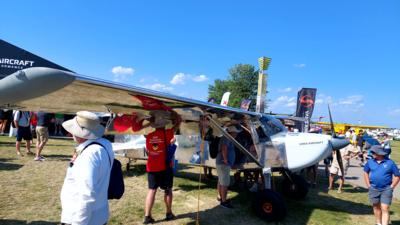Oddity’s Splendor... One of the 1000+ Aircraft Coming To The eSportPlane Resource Guide!
E-I-C Note: The eSPRG and ANN staff have been working furiously, behind the scenes on a new All-Digital, Next-Generation, SportPlane Resource Guide.

In addition to nearly 100 'How-To' chapters, dozens of appendices, THOUSANDS of videos and images, and other fonts of SportPlane knowledge, we estimate that some 1000 or so SportPlanes and Sport Aircraft will eventually be profiled. Herewith; a sample profile of one of the many, many, MANY aircraft coming up for the next eSPRG... while also noting that the published eSPRG profiles will also include even more info, pictures, data and (where possible) detailed and carefully critical Report Cards detailing the capabilities and suitability of the manufacturer and the aircraft in question. We have a massive job ahead of us... and the first few hundred pages, of the 2000 or so that we expect to publish online, will hit the AeroVerse in just a few weeks... Don't miss them! YOUR suggestions and comments about this, and other concepts and formats, planned for the eSPRG are not only welcomed, but STRONGLY encouraged... after all, we're doing this for YOU... the current and future SportPlane reader,
owner, builder, and pilot.
The announcement at AirVenture 2021 that Van’s Aircraft—the famed light-sport aircraft marque—was to produce its first high-wing model, the RV-15, was met with varying degrees of surprise and disbelief.

In the 18-months since, surprise and disbelief have given way to keen senses of eagerness and anticipation within the light-sport aircraft community, and legions of light-sport aircraft enthusiasts have begun readying their wallets and workshops for the arrival of their RV-15 kits.
The maturation of the RV-15 design has proceeded largely apace, and the good people at Van’s Aircraft have kept potential buyers well abreast of developments within the aircraft’s ground and flight-test programs.
To date, Van’s has disclosed that the RV-15 will be a high-wing, all metal, conventional landing-gear (tailwheel) backcountry-capable aircraft featuring a 2+2 seating configuration, floor-mounted control sticks, and all new landing-gear architecture and suspension. The RV-15’s main landing-gear assemblies include four internal oil/nitrogen shock absorbers to cushion the impact of landing on rough surfaces, avoid bounces, and improve directional control during takeoffs and landings. The tailwheel, too, has a dedicated pneumatic shock absorber. The airplane’s fairly shallow, ten-degree deck angle preserves over-nose visibility in the take-off and landing attitudes, and—in conjunction with the sophisticated landing-gear suspension system—stands to afford pilots solid ground handling even on primitive or non-existent runways.

Van’s decision to utilize pull rivets rather than the more traditional flush variety is predicated upon the success of pull rivet joinery in the company’s RV-12 model. What’s more, unlike flush rivets, which require a second set of hands to buck from behind, pull rivets can easily be installed by a lone home-builder.
The RV-15’s constant-chord wing, though not as aerodynamically efficient as a tapered wing, is far easier for home-builders to assemble insomuch as the entirety of its ribs are identical. The model’s deep-chord Friese ailerons represent a departure from Van’s aerodynamic orthodoxies, but are necessitated by the fact that approximately two-thirds of the RV-15’s wingspan is devoted to Fowler flaps which, on the prototype aircraft, deploy via an overhead cockpit lever to a riotously lift-and-drag-inducing fifty-degrees. By way of comparison, a Cessna 182’s flap travel is limited to thirty-degrees. The RV-15 occasions Van’s first foray into Fowler flaps.
For all its wondrous oddities and eccentricities, the RV-15’s empennage is arguably the contraption’s most unusual aspect—if only because its proportions appear abjectly exaggerated. The airplane’s vertical stabilizer is immense, as is its mass-balanced rudder. By comparison the RV-15’s stabilator seems comically diminutive.
Notwithstanding its relatively modest bearing, the stabilator serves key purposes in the RV-15’s immediate and near futures. Realizing a high-wing airplane with Fowler flaps that deploy up to fifty-degrees would be susceptible to powerful nose-down pitching forces, Van’s engineers opted to equip the RV-15 with a stabilator and a servo-tab which collectively afford greater surface area and pitch authority than a conventional fixed-horizontal stabilizer/elevator assembly. Aerodynamicists and general aviation pundits posit the RV-15’s expansive empennage speaks to the possibility of a near-term floatplane iteration of the aircraft.
To the subjects of power and drive-train, the RV-15 is designed to accommodate four-cylinder Lycoming engines of 180 to 220-horsepower. The engineering test prototype is kitted out with a four-cylinder Lycoming IO-390 EXP-119 engine outputting approximately 220-horsepower and driving an eighty-inch composite Hartzell Trailblazer propeller.

Van’s engineers, though notoriously reticent about the RV–15’s performance figures, have intimated the prototype aircraft is meeting an ambitious set of design criteria—which include take-offs and landings in four-hundred-feet or less and a level-flight top-speed of 140-knots. The RV-15’s stall speeds, too, have yet to be disclosed, but the fact the prototype sports neither vortex generators nor wing slats suggests the lack of need for such, thereby connoting slow and docile stall characteristics.
In flight, the RV-15’s airframe is advertised to handle loadings of 4.4 positive and 2.2 negative Gs, while hauling aloft an estimated 900-pound useful load.
Since being founded by Dick VanGrunsven in 1972, Van’s Aircraft has designed and built flying machines under the guiding principle of Total Performance. Van’s models, in point of fact, are neither overly speedy, overly agile, overly mighty, or overly long-legged. They are, however, superbly balanced, and offer builders and pilots a uniquely pleasing synthesis of versatility, utility, efficiency, robustness, and inexhaustible enjoyment.



 Unfortunate... ANN/SportPlane Resource Guide Adds To Cautionary Advisories
Unfortunate... ANN/SportPlane Resource Guide Adds To Cautionary Advisories ANN FAQ: Turn On Post Notifications
ANN FAQ: Turn On Post Notifications ANN's Daily Aero-Term (04.29.24): Visual Approach Slope Indicator (VASI)
ANN's Daily Aero-Term (04.29.24): Visual Approach Slope Indicator (VASI) ANN's Daily Aero-Term (04.28.24): Airport Marking Aids
ANN's Daily Aero-Term (04.28.24): Airport Marking Aids ANN's Daily Aero-Linx (04.28.24)
ANN's Daily Aero-Linx (04.28.24)








